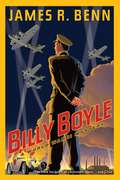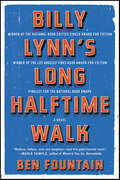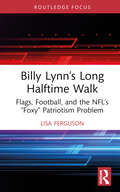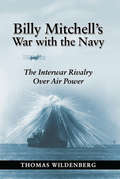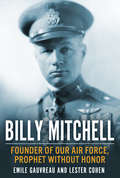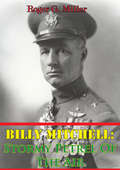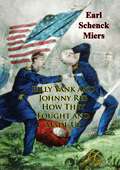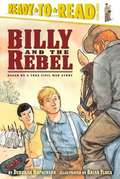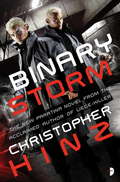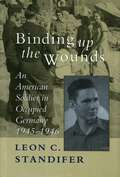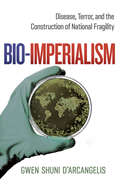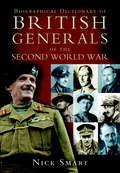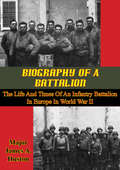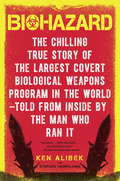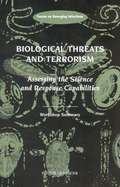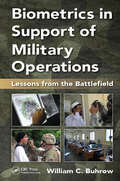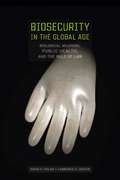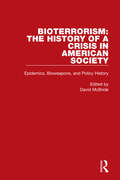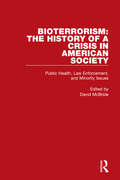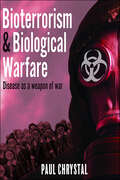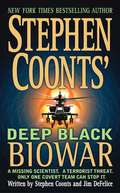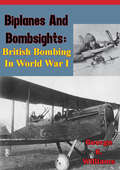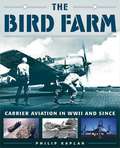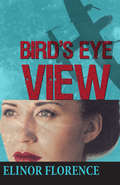- Table View
- List View
Billy Bishop: Canadian Hero
by Dan MccafferyBilly Bishop is Canada's greatest air ace of all time. He was almost thrown out of military college for cheating, but he went on to become the most famous of the First World War fighter pilots.<P> Though he became a darling of the press, Bishop grew tired of the carnage of the war.<P> Author Dan McCaffery offers a lively, compelling portrait of Bishop. His meticulous research has settled, once and for all, the controversy over whether Bishop lied to win his Vicotria Cross.<P> Warts and all, Bishop emerges as a true Canadian hero.
Billy Boyle: A World War Ii Mystery (Billy Boyle World War II Mystery #1)
by James R. Benn"This book has got it all--an instant classic."--Lee Child, author of The Hard Way "It is a pleasure marching off to war with the spirited Billy Boyle. He is a charmer, richly imagined and vividly rendered, and he tells a finely suspenseful yarn."--Dan Fesperman, author of The Prisoner of Guantanamo What's a twenty-two-year-old Irish American cop who's never been out of Massachusetts before doing at Beardsley Hall, an English country house, having lunch with King Haakon of Norway? Billy Boyle himself wonders. Back home in Southie, he'd barely made detective when war was declared. Unwilling to fight--and perhaps die--for England, he was relieved when his mother wangled a job for him on the staff of a general married to her distant cousin. But the general turns out to be Dwight D. Eisenhower, whose headquarters are in London, which is undergoing the Blitz. And Uncle Ike wants Billy to be his personal investigator. Billy is dispatched to the seat of the Norwegian government in exile. Operation Jupiter, the impending invasion of Norway, is being planned, but it is feared that there is a German spy amongst the Norwegians. Billy doubts his own abilities, with good reason. A theft and two murders test his investigative powers, but Billy proves to be a better detective than he or anyone else expected.
Billy Lynn's Long Halftime Walk: A Novel
by Ben FountainThis award-winning satire shares a day in the life of a nineteen-year-old U.S. soldier home on leave from the Iraq War to take part in an NFL halftime show.A ferocious firefight with Iraqi insurgents at “the battle of Al-Ansakar Canal”—three minutes and forty-three seconds of intense warfare caught on tape by an embedded Fox News crew—has transformed the eight surviving men of Bravo Squad into America’s most sought-after heroes. For the past two weeks, the Bush administration has sent them on a media-intensive nationwide Victory Tour to reinvigorate public support for the war. Now, on this chilly and rainy Thanksgiving, the Bravos are guests of America’s Team, the Dallas Cowboys, slated to be part of the halftime show alongside the superstar pop group Destiny’s Child.Among the Bravos is the Silver Star–winning hero of Al-Ansakar Canal, Specialist William Lynn, a nineteen-year-old Texas native. Amid clamoring patriots sporting flag pins on their lapels and Support Our Troops bumper stickers on their cars, the Bravos are thrust into the company of the Cowboys’ hard-nosed businessman/owner and his coterie of wealthy colleagues; a luscious born-again Cowboys cheerleader; a veteran Hollywood producer; and supersized pro players eager for a vicarious taste of war. Among these faces Billy sees those of his family—his worried sisters and broken father—and Shroom, the philosophical sergeant who opened Billy’s mind and died in his arms at Al-Ansakar.Over the course of this day, Billy will begin to understand difficult truths about himself, his country, his struggling family, and his brothers-in-arms—soldiers both dead and alive. In the final few hours before returning to Iraq, Billy will drink and brawl, yearn for home and mourn those missing, face a heart-wrenching decision, and discover pure love and a bitter wisdom far beyond his years . . . Poignant, riotously funny, and exquisitely heartbreaking, Billy Lynn's Long Halftime Walk is a devastating portrait of our time, a searing and powerful novel that cements Ben Fountain’s reputation as one of the finest writers of his generation.Now a major motion picture directed by Ang LeePraise for Billy Lynn’s Long Halftime WalkFinalist for the National Book AwardWinner, National Book Critics Circle Award for Fiction Winner, Los Angeles Times Book Award for Fiction“Brilliantly done . . . grand, intimate, and joyous.” —New York Times Book Review“The Catch-22 of the Iraq War.” —Karl Marlantes
Billy Lynn’s Long Halftime Walk: Flags, Football, and the NFL’s “Foxy” Patriotism Problem (Routledge Focus on Literature)
by Lisa FergusonThis book examines how the game of football and militarism have historically overlapped due to their shared celebration of strength, might, and besting a clear and definitive foe. Nevertheless, since September 11, a variety of staged patriotic vignettes dominated most NFL broadcasts, giving the once easy and unforced union a stilted feel. That the War on Terror became a fixture of modern- day Super Bowls was easy to portend; what was more difficult to predict was the imprint it would leave on U.S. citizens and American politics. Ben Fountain’s award- winning novel, Billy Lynn’s Long Halftime Walk, reveals what passes for patriotism in a country that has reduced the sober and stark reality of combat to pageantry and production for the crowd back home, leaving our troops to unwittingly play the part of entertainers, destined to be sexualized just like the cheerleaders and dancers so frequently performing alongside them.
Billy Mitchell's War with the Navy
by Thomas WildenbergIn the years following WWI, the U.S. Congress was more interested in disarmament than in funding national defense. For the military services this meant lean budgets and skeleton operating forces. Billy Mitchell's War recounts the struggle between the Army and Navy air arms for the resources needed to define and establish the role of aviation within their respective services in the period between the two world wars. When Billy Mitchell returned from WW I, he brought with him the deep-seated belief that air power had made armies and navies obsolete. When Congress rejected the concept of a unified air service in 1920, Mitchell and his supporters turned on the Navy, seeking to substitute the Air Service as the nation's first line of defense. While Mitchell proved that aircraft could sink a battleship with the bombing of the Ostfriesland in 1921, he was unable to convince the General Staff of the Army, the General Board of the Navy, the Secretary of War, the Secretary of the Navy, or Congress of the need for an independent air force. When Mitchell turned to the pen to discredit the Navy, he was convicted by his own words and actions in a court-martial that captivated the nation, and was forced to resign in 1925. Rather then ending the rivalry for air power, Mitchell's resignation set the stage for the ongoing dispute between the two services in the years immediately before WWII.
Billy Mitchell: Founder of our Airforce, Prophet Without Honor
by Emile Gauvreau Lester CohenBilly Mitchell: Founder of Our Air Force and Prophet without Honor, first published in 1942, is a look at the life and controversial career of William “Billy” Mitchell (1879-1936), considered the father of the U.S. Air Force. The book's focus is on Mitchell's campaign for increased spending for building new and improved aircraft and his vision of the role aircraft would play in any future wars, especially against naval ships. Mitchell's outspokenness led to his court-martial for insubordination in 1925.
Billy Mitchell: Stormy Petrel Of The Air [Illustrated Edition]
by Roger G. MillerIncludes 25 illustrationsA short but detailed biography of the prophet of American military Airpower - Billy Mitchell.On July 21, 1921, Brig. Gen. William "Billy" Mitchell circled high above the rough surface of the Chesapeake Bay, exultant witness to an event he had orchestrated and produced. Shortly after noon, the mortally wounded, former-German battleship Ostfriesland began to roll, turning completely over while air escaping from the huge hull gave sounds that some present interpreted as the sighs of a great beast dying. By one o'clock it was over, and Ostfriesland had slipped below the surface. It was not the sinking that was unique, however. Modern battleships had sunk before. They had been lost in storms and split their hulls on reefs and rocks. They had been hit by torpedoes, crushed by shell fire, and even sunk by mines and scuttling charges. But no battleship had ever gone to the bottom as the direct result of aerial bombs dropped from the fragile airplane, a new invention then barely eighteen years old. Disbelieving observers aboard the nearby U.S.S. Henderson were shocked, appalled, and dismayed as the Ostfriesland disappeared. Among the naval officers were some with tears in their eyes. But for the outspoken, flamboyant Billy Mitchell it was fulfillment and vindication. He had prophesied that aircraft could sink battleships; had fought for the trials that had just taken place; and had selected, organized, and trained the airmen who had accomplished their mission. Sinking the Ostfriesland was in many ways the summit of his military career, and Billy was not about to let anyone ignore his victory. Command pennant streaming from his aircraft, Mitchell paraded past the Henderson waving his wings, rubbing salt into a deep Navy wound.
Billy Yank and Johnny Reb How They Fought and Made Up
by Earl Schenck MiersHere are the battles and the people of the Civil War presented from the point of view of the common soldiers who fought the battles and the common people who lived through the war.Earl Schenck Miers is one of the best known among writers on the Civil War. In this book he proves not only his thorough familiarity with his subject, but also his understanding of young people and his amazing ability to present strictly factual material in so dramatic a fashion that it becomes more exciting and moving than any imaginative adventure story could be.-Goodreads.Earl Schenck Miers (27 May 1910 – 17 November 1972) was an American historian. He wrote over 100 books, mostly about the history of the American Civil War. Some of them were intended for children, including three historic novels in the We Were There series.
Billy and the Rebel
by Deborah HopkinsonThis story is based on the life of Billy Bayly, a real boy who lived in Pennsylvania during the Civil War and had an unlikely friendship with a Southern soldier. Ready-to-Read books offer children a world of possibilities at four different reading levels: Pre-Level 1 Recognizing Words Word repetition Familiar words and phrases Simple sentences Level 1 Starting to Read Simple stories Increased vocabulary Longer sentences Level 2 Reading Independently More-complex stories Varied sentence structure Paragraphs and short chapters Level 3 Reading Proficiently Rich vocabulary More-challenging stories Longer chapters.
Binary Storm
by Christopher HinzNear the end of the 21st century, Earth is in chaos from environmental devastation and a vicious undeclared war against binaries, genetically engineered assassins. Composed of a single consciousness inhabiting two human bodies (tways), binaries are ruled by an alpha breed, the Royal Caste.Nick Smith, computer programmer and brilliant strategist, hooks up with Annabel Bakana, the savvy new director of E-Tech, an organization dedicated to limiting runaway technological growth. Together both romantically and professionally, they secretly assemble a small combat team to hunt and kill binaries.But there's a fly in the ointment, the mysterious team leader, Gillian. A tormented soul with an unseemly attraction to Annabel, his actions just might help the Royal Caste's cause and draw the world closer to Armageddon.Serving as both a stand-alone novel and prequel to Liege-Killer, Binary Storm is a futuristic tale of bold characters pushed to the brink in a dangerous world. Startling action, political intrigue and powerful themes that echo our contemporary era are fused into a plot brimming with twists and surprises.File Under: Science Fiction [ Paratwa / Double Trouble / Corporations Kill / An Undying Connection ]From the Trade Paperback edition.
Binding Up the Wounds: An American Soldier in Occupied Germany, 1945--1946
by Leon C. StandiferIn his highly acclaimed Not in Vain, Leon C. Standifer recounted his experiences as a small-town Mississippi boy who at age nineteen found himself fighting as a combat infantryman in World War II France and Germany. Binding up the Wounds carries the story beyond V-E Day to describe what the author saw, heard, felt, and learned as a member of the American occupation army in the homeland of its defeated enemy.Standifer, who served in the 94th Infantry Division in western Germany, the Sudetenland, and Bavaria in the first year of occupation, chronicles that unique and chaotic time from the viewpoint of a typical GI. Germany was an epic landscape of human need, and cities lay in ruins. But the war was over, light and laughter were once again possible, and, as Standifer recalls, "we had a ball during that first year." Among the things he experienced or witnessed were black-market operations large and small (American cigarettes served as a universal currency, and a few ounces of mess-hall grease or used coffee grounds were valuable commodities); the spectacle of gung-ho officers attempting to turn combat troops into spit-and-polish paraders; the exploitive games played between American soldiers and German women; a gut-wrenching visit to a displaced persons camp; and the difficulties involved in guarding captured soldiers who were no longer the enemy.Perhaps most revealing, and often surprising, are the attitudes Standifer discovered among ordinary Germans toward the war, the Nazis, the "Hitler times" in general-not only during the occupation, but also decades later when he revisited Germany and spoke with elderly survivors of those times. For there are really two voices telling the tale of Binding Up the Wounds. One is that of the combat-hardened but otherwise naive twenty-year-old who lived the experiences. The other is that of the author as retired college professor looking back over half a century and puzzling out what those experiences meant for himself, for America, and for humankind.
Bio-Imperialism: Disease, Terror, and the Construction of National Fragility
by Gwen Shuni D'ArcangelisBio-Imperialism focuses on an understudied dimension of the war on terror: the fight against bioterrorism. This component of the war enlisted the biosciences and public health fields to build up the U.S. biodefense industry and U.S. global disease control. The book argues that U.S. imperial ambitions drove these shifts in focus, aided by gendered and racialized discourses on terrorism, disease, and science. These narratives helped rationalize American research expansion into dangerous germs and bioweapons in the name of biodefense and bolstered the U.S. rationale for increased interference in the disease control decisions of Global South nations. Bio-Imperialism is a sobering look at how the war on terror impacted the world in ways that we are only just starting to grapple with.
Biographical Dictionary of British Generals of the Second World War
by Nicholas SmartThe six years of prolonged world-wide conflict spawned some 340 serving generals in the British Army. A number are household names (Montgomery, Slim, Wavell) and others well known to historians (Horrocks, Dempsey, Leese). But the vast majority are forgotten except by their families and regiments. Yet there were a number of extraordinary characters, ranging from highly competent to downright inadequate. The Author has researched and written entries on all, varying in length, according to the subjects importance.
Biography Of A Battalion: The Life And Times Of An Infantry Battalion In Europe In World War II
by Major James A. HustonDuring World War II, James A Huston served as an operations officer in the 3rd Battalion, 134th Infantry, a unit that helped to liberate or capture dozens of cities across France, Belgium, and Germany. From July 1944 through April 1945, the regiment captured 8,974 prisoners of war and covered over 1,500 combat miles, but lost 10,046 men in the process."Biography of a Battalion" recreates the action and provides an account of the war from one soldier who lived through it.
Biohazard: The Chilling True Story of the Largest Covert Biological Weapons Program in the World--Told from the Inside by the Man Who Ran It
by Stephen Handelman Ken AlibekImagine a hot zone in which Ebola is being spliced--using the latest techniques of genetic engineering--with smallpox, the most infectious disease known to man. Now imagine that cocktail is meant for you. For fifty years, while the world stood in terror of a nuclear war, Russian scientists hidden in heavily guarded secret cities refined and stockpiled a new kind of weapon of mass destruction--an invisible weapon that would strike in silence and could not be traced. It would leave hundreds of thousands dead in its wake and would continue to spread devastation long after its release. The scientists were bioweaponeers, working to perfect the tools of a biological Armageddon. They called it their Manhattan Project. It was the deadliest and darkest secret of the cold war. What you are about to read has never before been made public. Ken Alibek began his career as a doctor wanting to save lives and ended up running the Soviet biological weapons program--a secret military empire masquerading as a pharmaceutical company. At its peak, the program employed sixty thousand people at over one hundred facilities. Seven reserve mobilization plants were on permanent standby, ready to produce hundreds of tons of plague, anthrax, smallpox, and Venezuelan equine encephalitis, to name only a few of the toxic agents bred in Soviet labs. Almost every government ministry was implicated, including the Academy of Sciences and the KGB. Biohazard is a terrifying, fast-paced account of tests and leaks, accidents and disasters in the labs, KGB threats and assassinations. The book is full of revelations--evidence of biowarfare programs in Cuba and India, actual deployments at Stalingrad and in Afghanistan, experiments with mood-altering agents, a contingency plan to attack major American cities, and the true story behind the mysterious anthrax outbreak in Sverdlovsk. But beyond these is a twisted world of lies and mirrors, and the riveting parable of the greatest perversion of science in history. No one knows the actual capabilities of biological weapons better than Dr. Alibek. Many of the scientists who worked with him have been lured away from low-paying Russian labs to rogue regimes and terrorist groups around the world. In our lifetime, we will most likely see a terrorist attack using biological weapons on an American city. Biohazard tells us--in chilling detail--what to expect and what we can do. Not since Arthur Koestler's Darkness at Noon has there been such a book--a report from inside the belly of the beast.Praise for Biohazard "Harrowing . . . richly descriptive . . . [an] absorbing account."--The New York Times Book Review "Remarkable . . . terrifying revelations . . . [Ken Alibek's] overall message is ignored at great national peril."--Newsday "Read and be amazed. . . . An important and fascinating look into a terrifying world of which we were blissfully unaware."--Robin Cook, author of ContagionFrom the Hardcover edition.
Biological Threats and Terrorism: Workshop Summary
by Leslie A. Pray Stacey L. Knobler Adel A. F. MahmoudIn the wake of September 11th and recent anthrax events, our nation's bioterrorism response capability has become an imminent priority for policymakers, researchers, public health officials, academia, and the private sector. In a three-day workshop, convened by the Institute of Medicine's Forum on Emerging Infections, experts from each of these communities came together to identify, clarify, and prioritize the next steps that need to be taken in order to prepare and strengthen bioterrorism response capabilities. From the discussions, it became clear that of utmost urgency is the need to cast the issue of a response in an appropriate framework in order to attract the attention of Congress and the public in order to garner sufficient and sustainable support for such initiatives. No matter how the issue is cast, numerous workshop participants agreed that there are many gaps in the public health infrastructure and countermeasure capabilities that must be prioritized and addressed in order to assure a rapid and effective response to another bioterrorist attack.
Biometrics in Support of Military Operations: Lessons from the Battlefield
by William C. BuhrowBiometrics in Support of Military Operations: Lessons from the Battlefield examines and evaluates recent U.S. military experiences in Iraq and Afghanistan in the context of the use of biometrics and related technologies. The book takes a comprehensive look at how biometrics has been used to support various military operations and suggests ways that its uses can be further developed. It fills a void in understanding how to incorporate biometrics by providing a guide to develop and establish formal operational roles and procedures when applying the technology. Written in an informal style that makes it accessible to people who are not necessarily operators or technicians of biometrics technologies, this book bridges an existing gap to better educate leaders inside and outside of the U.S. military on the far-reaching potential of biometrics in support of tactical operations. It argues that the gap between those inside and outside the military is the result of failure to document lessons learned from battle experience, as well as a lack of a combined vision among the Joint Forces to fully recognize and exploit the capabilities of biometrics for enhanced future success. This book fills that gap. Biometrics has great potential as an effective tool if properly developed and utilized. The book concludes with a look at the future of emerging applications for the military but also considers a wider range of deployment of biometrics outside the military, such as in governmental organizations, including foreign diplomacy. Biometrics can be applied to any operational area that requires accurate and rapid identification of unknown individuals in order to support its operations and protect personnel and resources. Biometrics in Support of Military Operations is an important beginning point in an emerging field for gaining understanding and better mastery of biometrics.
Biosecurity in the Global Age
by Lawrence O. Gostin David P. FidlerFidler (law, Indian U. School of Law) and Gostin (global health law, Georgetown U. ) believe the US needs to formulate effective "biosecurity" policy to confront the twin threats of biological weapons and naturally occurring infectious disease. Proper formulation of this policy would involve a melding of traditional security policy and public health policy and would involve supervision of scientific endeavors in support of policy goals. Furthermore, it must be grounded firmly in the rule of law, they argue, and involve global governance. Annotation ©2008 Book News, Inc. , Portland, OR (booknews. com)
Bioterrorism: Epidemics, Bioweapons, and Policy History (Bioterrorism: The History of a Crisis in American Society)
by David McBrideOriginally published in 2003 and now reissued with a new introduction, this collection provides an invaluable, academic resource on the challenges bioterrorism posed for American society and institutions. Critically selected essays from a wide range of disciplines document and analyze the problems and implications for political, economic, and legal institutions, as well as the challenges a weapon of disease and fear can impose on public health and public policy. By placing bioterrorism into its historical context, this collection also traces the academic research and historical decisions that have contributed to the formation of American policies attempting to cope with a potentially catastrophic attack on the population in general and urban population in particular.
Bioterrorism: Public Health, Law Enforcement, and Minority Issues (Bioterrorism: The History of a Crisis in American Society)
by David McBrideOriginally published in 2003 and now reissued with a new introduction, this collection provides an invaluable, academic resource on the challenges bioterrorism posed for American society and institutions. Critically selected essays from a wide range of disciplines document and analyze the problems and implications for political, economic, and legal institutions, as well as the challenges a weapon of disease and fear can impose on public health and public policy. By placing bioterrorism into its historical context, this collection also traces the academic research and historical decisions that have contributed to the formation of American policies attempting to cope with a potentially catastrophic attack on the population in general and urban population in particular.
Bioterrorism & Biological Warfare: Disease as a Weapon of War
by Paul ChrystalA timely examination of the use of disease and germs as a weapon of mass destruction (WMD) and the threat bioterrorism poses in an increasingly unpredictable and volatile future. This important, disturbing and timely book focuses on on the use of disease and germs as a weapon of mass destruction (WMD) and the threat bioterrorism poses in an increasingly unpredictable and volatile future for the world. For context it traces developments from the earliest primitive but effective days of infectious rams, poison-tipped arrows and plague-infected corpses used as toxic, disease-spreading projectiles, to the twenty-first-century industrial scale weaponization of biomedicine. Paul Chrystal shows how biological weapons and acts of bioterrorism are especially effective at instilling terror, panic, death, famine and economic ruin on a large scale, shredding public confidence in governments and civilization itself. For the disaffected, lethal biological agents are comparatively easy to manufacture and obtain, and they have the benefit of being almost invisible and easy and quick to administer in lethal quantities through a variety of discreet delivery systems. Just what the terrorist wants. We explore the sinister connection between the industrial-scale proliferation of biological weaponry by state actors and the greater opportunities these growing bio-arsenals give to the increasingly scientific-minded and determined terrorist to manufacture his or her weapon of choice, taking advantage also of the state of the art sophisticated delivery systems. The epilogue analyzes the concerted but groundless 2022-2023 disinformation campaign conducted by Russia, with support from China, relating to the claim that public health facilities in Ukraine are 'secret U.S.-funded biolabs', purportedly developing biological weapons.
Biowar (Deep Black #2)
by Stephen Coonts Jim DefeliceDr. James Kegan, a world-renowned scientist specializing in germ warfare, has vanished from his upstate New York home. But this is no ordinary missing-persons case. Kegan has left behind an unidentified dead man with a .22 caliber hole in his skull-and a contact trail that leads to an alleged terrorist cell. Unraveling the mystery is a job for Kegan's best friend, NSA operative Charlie Dean. His mission is to infiltrate the scientist's circle of associates and decipher Kegan's confidential research. Dispatched to cover Charlie is Delta Force trooper Lia Francesca. The trail leads them to the core of a widespread killer fever that's been dormant for centuries-and its link to a virus that's quickly spreading victim by victim. With time running out Charlie and Lia must find Kegan, uncover his secrets, cut a terrorist threat to the quick, and stop the unimaginable outbreak of a new biological nightmare.
Biplanes and Bombsights: British Bombing In World War I
by George K. WilliamsThis study measures wartime claims against actual results of the British bombing campaign against Germany in the Great War. Components of the Royal Naval Air Service (RNAS), the Royal Flying Corps (RFC), and the Royal Air Force (RAF) conducted bombing raids between July 1916 and the Armistice. Specifically, Number 3 Wing (RNAS), 41 Wing of Eighth Brigade (RFC), and the Independent Force (IF) bombed German targets from bases in France. Lessons supposedly gleaned from these campaigns heavily influenced British military aviation, underpinning RAF doctrine up to and into the Second World War.Fundamental discrepancies exist, however, between the official verdict and the first-hand evidence of bombing results gathered by intelligence teams of the RAF and the US Air Service. Results of the British bombing efforts were demonstrably more modest, and costs in casualties and wastage far steeper, than previously acknowledged. A preoccupation with "moral effect" came to dominate the British view of their aerial offensives. Maj Gen Hugh M. Trenchard played a pivotal role in bringing this misperception to the forefront of public consciousness.After the Armistice, the potential of strategic bombing was officially extolled to justify the RAF as an independent service. The Air Ministry's final report must be evaluated as a partisan manifestation of this crusade and not as a definitive final assessment, as it has been mistakenly accepted previously.This study develops and substantiates a comprehensive evaluation of British long-range bombing in the First World War. Its findings run directly counter to the generally held opinion. Natural limitations, technical shortfalls, and aircrews lacking proficiency acted in concert with German defenses to produce far less results than those claimed.
Bird Farm: Carrier Aviation and Naval Aviators?A History and Celebration
by Philip KaplanSee the excitement and danger of life on an aircraft carrier like never before. How does it feel to sit aboard a thirty-ton jet and be hurled over a ship’s bow at 140 miles per hour? And how does a deck crew coordinate its efforts to achieve such a feat every thirty seconds? Offering a rare glimpse of life aboard an aircraft carrier, The Bird Farm paints a vivid and often hair-raising portrait of military aircraft carriers and carrier crews, and of the planes and pilots who depend on them. Based on archival research and interviews with veterans and contemporary carrier personnel, this stunning volume tells the story of the aircraft carrier--from the first ramshackle seaplane carriers to today’s nuclear-powered supercarriers--and celebrates their undeniable impact on modern warfare. Skyhorse Publishing, as well as our Arcade imprint, are proud to publish a broad range of books for readers interested in history--books about World War II, the Third Reich, Hitler and his henchmen, the JFK assassination, conspiracies, the American Civil War, the American Revolution, gladiators, Vikings, ancient Rome, medieval times, the old West, and much more. While not every title we publish becomes a New York Times bestseller or a national bestseller, we are committed to books on subjects that are sometimes overlooked and to authors whose work might not otherwise find a home.
Bird's Eye View
by Elinor FlorenceA Toronto Star Bestseller! Rose, a Canadian intelligence officer in Britain in World War II, struggles with conflicting feelings about the war and a superior’s attention. Rose Jolliffe is an idealistic young woman living on a farm with her family in Saskatchewan. After Canada declares war against Germany in World War II, she joins the British Women’s Auxiliary Air Force as an aerial photographic interpreter. Working with intelligence officers at RAF Medmenham in England, Rose spies on the enemy from the sky, watching the war unfold through her magnifying glass. When her commanding officer, Gideon Fowler, sets his sights on Rose, both professionally and personally, her prospects look bright. But can he be trusted? As she becomes increasingly disillusioned by the destruction of war and Gideon’s affections, tragedy strikes, and Rose’s world falls apart. Rose struggles to rebuild her shattered life, and finds that victory ultimately lies within herself. Her path to maturity is a painful one, paralleled by the slow, agonizing progress of the war and Canada’s emergence from Britain’s shadow.

